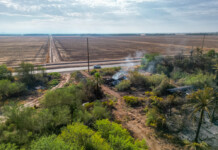
The Sisterhood of the Traveling Quilts donated 58 quilts this week to the Maricopa safe house being built by Against Abuse, Inc., Maricopa’s nonprofit organization working to prevent and help victims of domestic violence.
The quilting group also adopted a room in the shelter to furnish and decorate.
“None of us are wealthy or anything, but we wanted to do something,” said Brenda Campbell, the sisterhood’s blanket coordinator.
The quilts, called “comfort quilts” because of their lap-friendly size of 40 inches by 40 inches, will be given to every child who stays at the home.
Against Abuse board member Torri Anderson said quilts were perfect for helping to make the temporary shelter for victims of domestic violence feel at home.
“Once this shelter opens, it’s a home,” Anderson said. “And during that healing time, during the recovery, it’s really important to have that comfort and security.”
“The quilts, especially as they get better with time and are being used, it’s like comfort food, like mashed potatoes and gravy,” Anderson said. “It’s that thing that makes it all better.”
Previously, the Sisterhood spent a year working on a king-sized quilt auctioned during the annual Seeds of Change gala fundraiser for Against Abuse.
Campbell, in addition to making quilts on her own, helped the group meet its August charity goal by putting together kits for the other members.
“We are a small group and wanted to supply these to the shelter, but we just didn’t know what the demand would be,” Campbell said.
For 42 of the quilts, Campbell packed squares of pre-cut fabric, binding, backing and instructions into two-and-a-half gallon plastic bags.
“The members loved it,” Campbell said. “They would get these (bags) and everything was in it, except the batting.”
Although the group has some highly skilled seamstresses as members, all the patterns were basic.
“They’re all easy quilts,” Campbell said. “These aren’t heirloom quilts, but it’s an everyday quilt because we didn’t know how they would be used.”
Patterns ranged from brightly-colored quilts intended for very young children to “a few darker, more masculine patterns, for older teenagers and boys,” Campbell said.






![Maricopa’s ‘TikTok Rizz Party,’ explained One of several flyers for a "TikTok rizz party" is taped to a door in the Maricopa Business Center along Honeycutt Road on April 23, 2024. [Monica D. Spencer]](https://www.inmaricopa.com/wp-content/uploads/2024/04/spencer-042324-tiktok-rizz-party-flyer-web-218x150.jpg)




![City gave new manager big low-interest home loan City Manager Ben Bitter speaks during a Chamber of Commerce event at Global Water Resources on April 11, 2024. Bitter discussed the current state of economic development in Maricopa, as well as hinting at lowering property tax rates again. [Monica D. Spencer]](https://www.inmaricopa.com/wp-content/uploads/2024/04/spencer-041124-ben-bitter-chamber-property-taxes-web-218x150.jpg)




